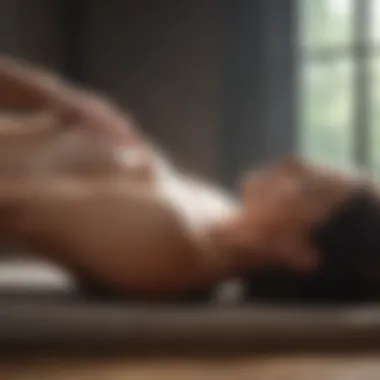Mastering the Art of Meditating While Laying Down for Enhanced Mindfulness


Understanding Mindfulness
Mindfulness is the practice of being fully present and aware of one's thoughts, feelings, sensations, and the surrounding environment. Its benefits are vast, ranging from reducing stress and anxiety to enhancing focus and mental clarity. Incorporating mindfulness into daily life can lead to a more balanced, fulfilling existence. By cultivating mindfulness through meditation while laying down, individuals can tap into a deep sense of relaxation and inner peace.
Importance of mindfulness in daily life
Mindfulness plays a crucial role in enhancing overall well-being. It allows individuals to stay grounded in the present moment, letting go of worries about the past or future. By practicing mindfulness regularly, one can improve their emotional regulation, focus, and decision-making. This heightened awareness fosters a deeper connection with oneself and the world around them.
Practices and techniques for cultivating mindfulness
Numerous techniques can aid in developing mindfulness, including deep breathing exercises, body scans, and visualization. These practices assist individuals in tuning into their bodies and quieting the mind. By incorporating these techniques into their daily routine, one can gradually enhance their ability to stay present and cultivate a more mindful way of living.
Guided Meditation Sessions
Engaging in guided meditation sessions while lying down offers individuals a structured approach to deepening their mindfulness practice. Various types of guided meditations are available, focusing on relaxation, self-awareness, and compassion. These sessions provide individuals with the necessary guidance to navigate their inner experiences and foster a sense of inner peace.
Different types of guided meditations available
Guided meditations range from body scan meditations to loving-kindness practices. Each type serves a specific purpose, whether it is grounding oneself in the present moment or cultivating feelings of kindness and compassion towards oneself and others. By exploring different guided meditation styles, individuals can find one that resonates with their unique needs.
How to start a guided meditation practice
To begin a guided meditation practice, find a quiet and comfortable space where you can lie down undisturbed. Select a guided meditation that aligns with your goals, whether it is stress relief, improved focus, or emotional healing. Follow the instructions provided by the meditation guide, allowing yourself to fully immerse in the experience.
Tips for enhancing the meditation experience
Creating a soothing environment with soft lighting, calming scents, and comfortable bedding can enhance the meditation experience. Additionally, focusing on your breath and letting go of distractions can deepen your connection to the present moment during the guided meditation.
Managing Stress and Anxiety
Stress and anxiety are common experiences in today's fast-paced world, impacting mental and physical health. Mindfulness techniques offer effective ways to reduce stress and anxiety levels, promoting relaxation and emotional well-being. By practicing mindfulness while lying down, individuals can alleviate tension and cultivate a greater sense of calm and resilience.
Causes and effects of stress and anxiety
Stress and anxiety can arise from various sources, such as work pressure, relationship challenges, or health concerns. These mental states can manifest in physical symptoms like muscle tension, insomnia, and digestive issues. Recognizing the triggers and effects of stress and anxiety is a crucial step towards managing them effectively.
Mindfulness techniques for reducing stress and anxiety
Mindfulness techniques like body scanning, progressive muscle relaxation, and conscious breathing can help individuals release pent-up tension and reduce anxious thoughts. By integrating these practices into their daily routine, individuals can enhance their emotional well-being and cope with stressful situations more skillfully.
Coping strategies for dealing with overwhelming emotions
In moments of overwhelming emotions, mindfulness offers valuable coping strategies to regain inner equilibrium. Engaging in mindfulness while lying down allows individuals to acknowledge their feelings without judgment, creating space for greater self-compassion and emotional resilience.
Improving Sleep Quality
Quality sleep is essential for overall well-being, influencing cognitive function, mood regulation, and physical health. Guided meditations tailored for better sleep can aid individuals in relaxing their minds and bodies before bedtime, promoting a restful night's sleep.


Importance of quality sleep for overall well-being
Adequate sleep is crucial for rejuvenating the body and mind, supporting optimal functioning throughout the day. Quality sleep promotes memory consolidation, emotional regulation, and immune system health. By prioritizing a restful sleep routine, individuals can enhance their overall well-being and cognitive performance.
Guided meditations for better sleep
Guided meditations designed to enhance sleep quality often focus on relaxation techniques, such as gentle body relaxation, rhythmic breathing, and calming visualization. These practices can help individuals unwind from the day's stressors and prepare their minds for a peaceful night's rest.
Tips for creating a calming bedtime routine
Establishing a calming bedtime routine can signal to the body that it is time to unwind and prepare for sleep. Avoiding screens, engaging in light stretching, and practicing relaxation exercises can promote a sense of serenity before bedtime. By incorporating guided meditations into this routine, individuals can further enhance their sleep quality.
Enhancing Mindfulness at Work
Mindfulness practices offer valuable tools for improving work productivity, focus, and overall well-being. By integrating mindfulness techniques into the workday, individuals can effectively manage stress, enhance creativity, and foster a more positive work environment.
Benefits of mindfulness in improving work productivity
Mindfulness cultivates a sense of mental clarity and presence that can enhance work performance and decision-making. By reducing distractions and increasing focus, individuals can complete tasks more efficiently and creatively. This heightened awareness also promotes effective communication and collaboration in the workplace.
Mindful practices for a more focused and efficient workday
Incorporating short mindfulness practices into the workday, such as deep breathing exercises, brief body scans, or mini meditation breaks, can boost focus and productivity. These practices enable individuals to reground themselves amidst busy schedules and demanding deadlines, fostering a sense of calm amid the work-related chaos.
Techniques for managing work-related stress
Work-related stress can lead to burnout and decreased job satisfaction. Mindfulness techniques like mindful breathing, mindful walking, and setting boundaries can help individuals manage and reduce stress levels at work. By integrating these techniques into their daily routine, individuals can navigate work challenges with greater resilience and composure.
Intro to Meditating While Laying Down
Meditating while laying down is a practice that offers a unique approach to mindfulness and relaxation. In this article, we delve into the importance of embracing meditation in a reclined position. By exploring various elements such as body alignment, breathing techniques, and environmental setup, readers can enhance their meditation experience significantly. Understanding the nuances of horizontal meditation can bring about a profound shift in one's mental well-being and overall quality of life.
Understanding the Concept of Meditating While Laying Down
The Evolution of Meditation Positions
Exploring the evolution of meditation positions reveals a rich history of how individuals have adapted their practices over time. The transition to laying down while meditating signifies a departure from traditional seated postures, allowing for greater physical comfort and relaxation. The key characteristic of this evolution lies in its emphasis on optimizing relaxation and promoting a sense of ease during meditation sessions. By embracing this approach, practitioners can explore new depths of tranquility and mindfulness in their practice, offering an alternative to more conventional seated methods.
The Practice of Horizontal Meditation
Horizontal meditation, as a practice, prioritizes accessibility and comfort. By laying down during meditation, individuals can harness the benefits of relaxation and alignment more effectively. This method's unique feature lies in its ability to foster a deeper connection between the mind and body, promoting a sense of profound calm and introspection. While this approach may not be suitable for all practitioners, those seeking a different meditation experience can explore the advantages it offers for enhancing overall well-being.
Benefits of Meditating in a Reclined Position
Enhanced Relaxation
Engaging in meditation in a reclined position amplifies the relaxation response within the body. This method's key characteristic is its ability to induce a deep sense of calm and tranquility, allowing practitioners to unwind more effectively. The unique feature of enhanced relaxation is its capacity to reduce stress levels and promote mental clarity, facilitating a more rejuvenating meditation experience overall.


Improved Body Comfort
Opting for a reclined meditation position enhances physical comfort during practice. The key characteristic of improved body comfort is its focus on alleviating strain and tension commonly experienced in seated postures. By embracing this method, individuals can reduce discomfort and enhance their overall meditation experience, fostering a more sustainable and enjoyable practice.
Deeper Mind-Body Connection
Meditating in a reclined position nurtures a deeper mind-body connection, creating an immersive experience for practitioners. The key characteristic here is the profound sense of unity between mental and physical aspects, promoting a holistic approach to mindfulness. The unique feature of this connection lies in its potential to enhance self-awareness and cultivate a profound sense of inner harmony, enriching the meditation journey significantly.
Challenges and Considerations
Maintaining Focus
One of the primary challenges of meditating while laying down is maintaining focus throughout the practice. The key characteristic here is the need to sustain mental clarity and prevent drifting into a state of drowsiness or distraction. While this method offers enhanced relaxation, practitioners must cultivate mindfulness to ensure a productive and rejuvenating meditation experience.
Potential for Distractions
Another consideration is the potential for distractions that may arise when meditating in a reclined position. The key characteristic to be mindful of is the susceptibility to external stimuli and inner thoughts that could disrupt the meditative state. By acknowledging and addressing these distractions, individuals can navigate this challenge effectively, fostering a more profound and immersive meditation practice.
Techniques for Meditating While Laying Down
When delving into the realm of meditating while laying down, it becomes paramount to grasp the techniques that can elevate this practice to a zenith of mindfulness. Techniques for meditating while reclined serve as the foundation upon which one's relaxation and mental well-being are built. These techniques encompass a range of elements, each offering unique benefits and considerations vital for optimizing the horizontal meditation experience. Understanding the intricacies of body alignment and posture, mastering breathing exercises, and embracing guided visualization techniques are all integral components that culminate in a holistic approach to meditating while laying down. By exploring and honing these techniques, individuals can harmonize their mind, body, and spirit with unparalleled depth and serenity.
Body Alignment and Posture Tips
Spinal Alignment
Delving into the nuances of spinal alignment in the context of meditating while laying down unveils a pivotal aspect of posture that significantly impacts one's overall well-being during the practice. Ensuring proper spinal alignment not only promotes physical comfort but also facilitates smooth energy flow throughout the body, fostering a harmonious connection between mind and body. The characteristic essence of spinal alignment lies in its ability to maintain the natural curve of the spine, aligning vertebrae in a manner that minimizes strain and maximizes relaxation. Embracing spinal alignment as a cornerstone of horizontal meditation offers a plethora of advantages, from preventing skeletal imbalances to enhancing the efficacy of breathing exercises. While embracing spinal alignment, individuals may encounter challenges related to maintaining this posture for extended periods, yet the benefits far outweigh any temporary discomfort, paving the way for a profound meditative experience.
Head and Neck Position
In the realm of meditating while reclined, the positioning of the head and neck emerges as a critical factor influencing the depth and efficacy of one's practice. Establishing optimal head and neck alignment not only promotes physical comfort but also ensures that the flow of energy remains unobstructed throughout the meditative session. The key characteristic of head and neck positioning lies in its ability to align the head with the spine, reducing strain on neck muscles and facilitating a seamless flow of relaxation from the crown to the base of the spine. This alignment choice garners popularity for its capacity to alleviate tension commonly held in the neck and shoulders, allowing individuals to delve into a state of deep relaxation with ease. While exploring head and neck positioning, individuals may find that maintaining this alignment demands conscientious effort, yet the rewards in terms of enhanced focus and relaxation are immeasurable.
Leg and Arm Placement
The positioning of legs and arms during horizontal meditation holds immense significance in sculpting a posture that nurtures both physical comfort and mental tranquility. Optimal leg and arm placement forms the crux of a relaxed and balanced posture, granting the body the stability it requires to delve into the depths of meditation. The key characteristic of leg and arm placement lies in its ability to support the natural alignment of joints and muscles, preventing unnecessary strain and fostering a sense of groundedness essential for a fruitful meditative experience. Choosing to align legs and arms in a manner that promotes relaxation and blood circulation reaps numerous benefits, from reducing muscular tension to enhancing the overall sense of comfort and serenity during meditation. While refining leg and arm placement, individuals may encounter challenges related to achieving and sustaining the ideal posture, yet with consistent practice, the body adapts, paving the way for a seamless and profound meditative journey.
Breathing Exercises for Horizontal Meditation
Diaphragmatic Breathing
Within the landscape of horizontal meditation, diaphragmatic breathing emerges as a cornerstone practice that not only nourishes the body with essential oxygen but also paves the way for profound relaxation and mental clarity. Embracing diaphragmatic breathing involves engaging the diaphragm muscle to its full capacity, enabling deeper inhalation and exhalation that revitalizes the body and calms the mind. The key characteristic of diaphragmatic breathing lies in its ability to activate the parasympathetic nervous system, inducing a state of calm that permeates every facet of one's being. This breathing technique gains favor for its effectiveness in reducing stress, improving oxygen circulation, and enhancing overall well-being through regular practice. While immersing in diaphragmatic breathing, individuals may encounter initial challenges related to breath control and muscle coordination, yet with dedication and patience, the rewards manifest in a heightened sense of inner peace and vitality.
Counted Breaths Technique
As individuals traverse the horizons of horizontal meditation, the counted breaths technique emerges as a potent tool for cultivating mindfulness and focus during the practice. Engaging in the counted breaths technique involves attentively counting each inhalation and exhalation, anchoring the mind in the rhythmic flow of breath to transcend distractions and deepen meditative awareness. The key characteristic of the counted breaths technique lies in its ability to synchronize breath with consciousness, fostering a state of heightened presence and tranquility that transcends the fluctuations of the mind. This technique's appeal resides in its capacity to enhance concentration, regulate breathing patterns, and dissolve mental chatter, making it an invaluable ally for those seeking to enrich their meditative experience. While integrating the counted breaths technique, individuals may encounter challenges related to mental restlessness and maintaining focus, yet with consistent practice, the mind becomes attuned to the rhythmic cadence of breath, opening doors to profound states of inner stillness and clarity.
Guided Visualization and Relaxation Techniques


Creating Mental Images
Unlocking the realms of guided visualization within horizontal meditation unveils an intricate tapestry of mental imagery that serves as a gateway to profound relaxation and heightened awareness. Engaging in creating mental images involves conjuring vivid scenes or sensations within the mind's eye, immersing oneself in a world of personalized tranquility and serenity. The key characteristic of creating mental images lies in its ability to harness the power of imagination to sculpt an inner landscape that fosters deep relaxation, visualization, and emotional healing. This technique's allure rests in its capacity to stimulate creativity, evoke positive emotions, and enhance the overall meditative experience with a personalized touch. While navigating the realms of creating mental images, individuals may encounter challenges related to mental clarity and visualization, yet with gentle guidance and practice, the mind becomes adept at painting vivid pictures that transport the individual to realms of inner peace and renewal.
Progressive Muscle Relaxation
Embarking on the journey of guided relaxation through progressive muscle relaxation presents individuals with a profound method for releasing tension, stress, and accumulated fatigue from the body. Embracing progressive muscle relaxation involves sequentially tensing and releasing different muscle groups, allowing the body to surrender to a state of deep rest and rejuvenation. The key characteristic of progressive muscle relaxation lies in its ability to heighten body awareness, relieve physical tension, and induce a profound sense of relaxation that emanates from within. This relaxation technique garners favor for its efficacy in promoting stress relief, improving sleep quality, and fostering a deep mind-body connection through conscious release of muscular tension. While immersing in progressive muscle relaxation, individuals may encounter challenges related to muscle coordination and relaxation, yet with patience and persistence, the body learns to surrender to a state of profound serenity, paving the way for holistic healing and rejuvenation.
Creating a Conducive Environment for Horizontal Meditation
In the realm of meditating while laying down, crafting a conducive environment holds paramount significance. The setting in which one engages with horizontal meditation can deeply influence the effectiveness of the practice and the overall experience. By focusing on specific elements within this context, practitioners can enhance their ability to achieve a profound state of relaxation and mindfulness. The elements that constitute an optimal environment for horizontal meditation encompass aspects such as the choice of comfortable mattresses or mats, the utilization of dim lighting, and the integration of ambient sounds to augment the meditative journey and promote a sense of tranquility.
Setting Up Your Space
Comfortable Mattress or Mat
When assembling your meditation space for a horizontal practice, the selection of a suitable mattress or mat emerges as a critical consideration. A comfortable surface is essential to support the body adequately and ensure proper alignment during meditation. The choice of a comfortable mattress or mat plays a pivotal role in facilitating relaxation and easing tension within the body. Opting for a supportive yet plush surface can contribute significantly to the overall comfort and effectiveness of the meditative experience.
Dim Lighting and Ambient Sounds
The incorporation of dim lighting and ambient sounds can significantly impact the ambience of the meditation space. Dim lighting creates a soothing atmosphere, reducing harsh visual distractions and promoting a sense of calm. Simultaneously, ambient sounds such as soft music or natural sounds like running water or gentle rustling leaves can help establish a serene and peaceful environment conducive to deep relaxation and focused meditation.
Minimizing Distractions
In the pursuit of horizontal meditation, minimizing distractions is crucial to maintaining a state of mental clarity and mindfulness. Distractions, whether external or internal, can impede the meditative process and disrupt the flow of concentration. By silencing electronic devices, such as phones and tablets, practitioners can eliminate potential disturbances and create a space free from disruptive noises or notifications, fostering a conducive environment for uninterrupted meditation.
Creating a Peaceful Atmosphere
Furthermore, cultivating a peaceful atmosphere within the meditation space is imperative for optimizing the horizontal meditation experience. Creating an environment that exudes tranquility and serenity helps individuals feel more at ease and promotes a deeper connection with their inner selves. By incorporating elements like soft colors, aromatherapy, or calming decor, practitioners can enhance the atmosphere and elevate their meditative practice to new levels of introspection and mindfulness.
Maximizing the Benefits of Horizontal Meditation
Maximizing the benefits of horizontal meditation plays a pivotal role in enhancing one's overall well-being. By integrating meditation into sleep patterns, individuals can experience a profound sense of relaxation and holistic rejuvenation. This section delves into the importance of optimizing the practice of horizontal meditation and maximizing its impact on both mental and physical health.
Integration with Sleep Patterns
Pre-Sleep Meditation
Exploring the realm of pre-sleep meditation unveils a gateway to a restful night's sleep. Engaging in mindfulness practices before bedtime can immensely improve sleep quality and facilitate a smoother transition into a state of deep rest. Pre-sleep meditation serves as a powerful tool for calming the mind and unwinding from the day's stresses, preparing the body and spirit for rejuvenating sleep. The deliberate focus on relaxation through pre-sleep meditation aids in decluttering the mind and establishing a tranquil mental space conducive to deep rest.
Deeper Sleep Induction
Delving into the techniques of deeper sleep induction illuminates the path towards a more profound and restorative slumber. By incorporating practices that support the induction of deep sleep, individuals can harness the power of meditation to optimize their rest cycles. Deeper sleep induction techniques focus on promoting relaxation at a profound level, allowing for a more replenishing and regenerative sleep experience. This facet of horizontal meditation enhances one's ability to access the restorative stages of sleep, facilitating a transformative nightly renewal process.
Emotional Release and Stress Relief
Coping with Emotional Turbulence
Navigating the intricacies of coping with emotional turbulence through meditation equips individuals with valuable tools for emotional regulation and well-being. Addressing emotional turbulence through mindfulness practices fosters resilience and emotional intelligence, empowering individuals to navigate challenging feelings with grace and composure. Coping with emotional turbulence through meditation nurtures self-awareness and inner strength, enabling individuals to respond to emotional upheavals with mindfulness and presence.
Relaxation for Stress Management
Embracing relaxation techniques for stress management unveils a holistic approach to mental well-being and emotional balance. Leveraging meditation for stress management offers a potent antidote to the modern-day pressures and demands, allowing individuals to cultivate a sense of calm and equanimity amidst life's challenges. Relaxation techniques tailored for stress management provide a sanctuary for the mind, fostering a harmonious state of being amid the tumultuous currents of daily life. Incorporating relaxation practices into one's mindfulness regimen cultivates a resilient mind and a tranquil spirit, essential anchors in the journey towards holistic wellness.







